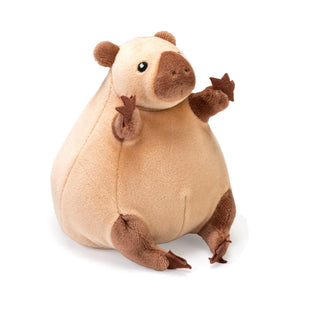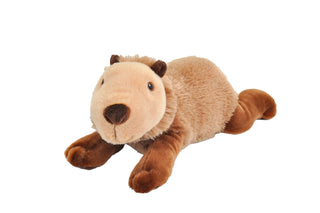Your Search For "capybara" Revealed The Following:
Filter
Active Filters
Flipkins Capybara Stuffed Animal - 5"
$10.99
- Unit price
- / per
INCLUDES:
- Age:0+
- Brand:Flipkins
- Gender:Boy
- Gender:Girl
- Size:5"
$10.99
- Unit price
- / per
Pocketkins Eco Capybara Stuffed Animal - 5"
$8.99
- Unit price
- / per
INCLUDES:
- Age:0+
- Brand:Pocketkins Eco
- Features:Eco
- Gender:Boy
- Gender:Girl
- Size:5"
$8.99
- Unit price
- / per
Huggers Capybara Stuffed Animal - 8"
$10.99
- Unit price
- / per
INCLUDES:
- Age:10M+
- Brand:Huggers
- Gender:Boy
- Gender:Girl
- Size:8"
$10.99
- Unit price
- / per
Ecokins Capybara Stuffed Animal - 12"
$19.99
- Unit price
- / per
INCLUDES:
- Age:0+
- Brand:Ecokins
- Features:Eco
- Gender:Boy
- Gender:Girl
- Size:12"
$19.99
- Unit price
- / per
Capybara Stuffed Animal - 8"
$11.99
- Unit price
- / per
INCLUDES:
- Age:0+
- Brand:Ecokins
- Gender:Boy
- Gender:Girl
- Size:8"
$11.99
- Unit price
- / per
Anteater Stuffed Animal - 8"
$11.99
- Unit price
- / per
INCLUDES:
- Age:0+
- Brand:Ecokins
- Gender:Boy
- Gender:Girl
- Size:8"
$11.99
- Unit price
- / per
Naked Mole Rat Stuffed Animal - 8"
$12.99
- Unit price
- / per
INCLUDES:
- Age:0+
- AnimalType:Naked Mole Rat
- Brand:Cuddlekins
- Gender:Boy
- Gender:Girl
- Naked Mole Rat
- Size:8"
$12.99
- Unit price
- / per
African Hedgehog Stuffed Animal - 12"
Regular price
$17.60
$21.99
Save 20%
- Unit price
- / per
INCLUDES:
- Age:0+
- AnimalType:Hedgehog
- Brand:Cuddlekins
- Gender:Boy
- Gender:Girl
- Hedgehog
- Size:12"
Regular price
$17.60
$21.99
Save 20%
- Unit price
- / per
Kangaroo Rat Stuffed Animal - 8"
$12.99
- Unit price
- / per
INCLUDES:
- Age:0+
- AnimalType:Kangaroo Rat
- Brand:Cuddlekins
- Gender:Boy
- Gender:Girl
- Kangaroo Rat
- Size:8"
$12.99
- Unit price
- / per
The Canopy Explorer Bundle
Regular price
$57.99
$67.95
Save 15%
- Unit price
- / per
INCLUDES:
- Cuddlekins Mini Squirrel Monkey 8"
- Cuddlekins Sloth 12"
- Flipkins Capybara 5"
- Hug'Ems Mini Sloth 7"
- Huggers Squirrel Monkey 8"
Regular price
$57.99
$67.95
Save 15%
- Unit price
- / per
Capybara Stuffed Animal - 12"
$22.99
- Unit price
- / per
INCLUDES:
- Age:0+
- AnimalType:Capybara
- Brand:Cuddlekins
- Capybara
- Gender:Boy
- Gender:Girl
- Size:12"
$22.99
- Unit price
- / per
Cuddlekins Eco Jumbo Capybara Stuffed Animal - 30"
$82.99
- Unit price
- / per
INCLUDES:
- Age:0+
- Brand:Cuddlekins Eco Jumbo
- Gender:Boy
- Gender:Girl
- Size:30"
$82.99
- Unit price
- / per
Pincher Capybara - 18"
$8.99
- Unit price
- / per
INCLUDES:
- Age:3+
- Brand:Pincher
- Gender:Boy
- Gender:Girl
- Size:18"
$8.99
- Unit price
- / per
Hug'ems Capybara Stuffed Animal - 7"
$9.99
- Unit price
- / per
INCLUDES:
- Age:0+
- Brand:Hug'ems
- Gender:Boy
- Gender:Girl
- Size:7"
$9.99
- Unit price
- / per
Mom & Baby Capybara Stuffed Animal - 9"
$22.99
- Unit price
- / per
INCLUDES:
- Age:0+
- Brand:Mom & Baby
- Gender:Boy
- Gender:Girl
- Size:9"
$22.99
- Unit price
- / per
Cuddlekins Eco Mini Capybara Stuffed Animal - 8"
$14.99
- Unit price
- / per
INCLUDES:
- Age:0+
- Brand:Cuddlekins Eco Mini
- Gender:Boy
- Gender:Girl
- Size:8"
$14.99
- Unit price
- / per
Cuddlekins Eco Pangolin Stuffed Animal - 12"
$24.99
- Unit price
- / per
INCLUDES:
- Age:0+
- Brand:Cuddlekins Eco
- Gender:Boy
- Gender:Girl
- Size:12"
$24.99
- Unit price
- / per
You're viewing 1-17 of 17 results

















